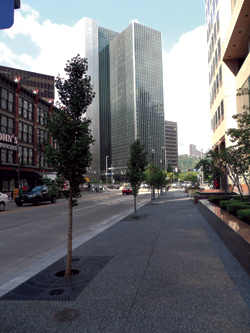WPC’s Tree Plantings Span Region
The Western Pennsylvania Conservancy’s first on-the-ground project involved the planting of trees in an urban setting. In 1940, while it was known as the Greater Pittsburgh Parks Association, WPC restored an area along the city’s Bigelow Boulevard that had been left barren by a landslide.

WPC is the managing partner of TreeVitalize Pittsburgh, which is planting thousands of trees in the Pittsburgh area.
The Conservancy’s urban forestry roots run deep, and for good reason. Studies show that trees help to build community pride, reduce crime, improve local economies and residential property values, decrease energy costs and improve air and water quality.
The Conservancy’s urban forestry efforts got a boost in 2008 when it became the managing partner of TreeVitalize Pittsburgh. WPC, together with the City of Pittsburgh, Allegheny County, the Pennsylvania Department of Conservation and Natural Resources and Tree Pittsburgh, established this partnership to significantly increase the number of trees planted in the Pittsburgh region. TreeVitalize Pittsburgh’s current goal is to plant 20,000 by the end of this year – the partnership has already planted more than 17,000.
While Pittsburgh prizes its high rankings on many livability indexes, one area with major room for improvement is the number of street trees per capita. The national average of one street tree for every three residents dwarfs Pittsburgh’s 1:11 ratio; in some neighborhoods like Homewood the ratio is as low as 1:22.
But the Conservancy doesn’t just focus on urban forestry; the WPC Watershed Conservation Program currently is planting thousands of native trees and woody plants along streams.
The Richard King Mellon Foundation provided financial support for this project.
WPC aims to plant 20,000 trees or shrubs within selected watersheds over the next two years. This project will improve priority watersheds in Western Pennsylvania by planting in riparian zones, or land adjacent to streams, to improve water quality and fish habitat. Potential sites could include agricultural fields, pastures, actively mowed and maintained areas or any idle stream banks that are in need of trees.
Stream banks that lack vegetative cover can erode excessively and contribute to increased sedimentation on the stream. Many streams in priority watersheds around Western Pennsylvania are impaired by excess sediment loads caused by erosion that is associated with a lack of woody vegetation. Research suggests forested buffers provide many benefits, including protection from erosion, the creation of wildlife habitat and cooler water temperatures for aquatic organisms.
